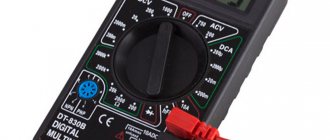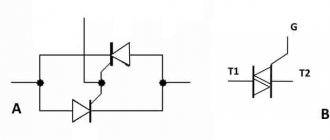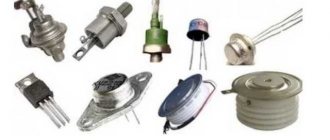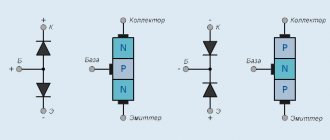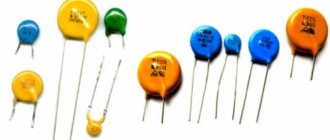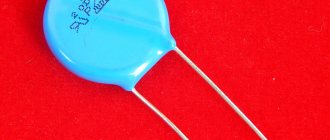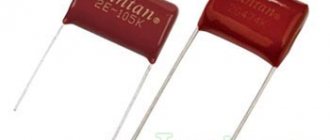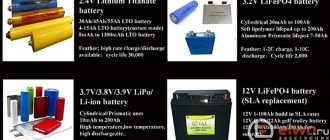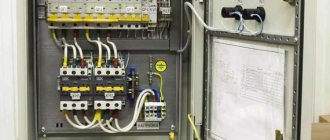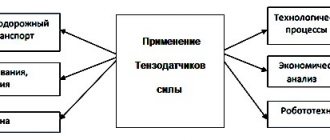What is an electric filter
An electrical filter is a device for selecting desirable components of the spectrum (frequencies) of an electrical signal and/or suppressing unwanted ones.
For other frequencies that are not included in the passband, the filter creates large attenuation, up to their complete disappearance. The characteristics of an ideal filter should cut out a strictly defined frequency band and “squeeze” other frequencies until they are completely attenuated. Below is an example of an ideal filter that passes frequencies up to a certain cutoff frequency value.
In practice, such a filter is impossible to implement. When designing filters, they try to get as close as possible to the ideal characteristic. The closer the frequency response characteristic is to an ideal filter, the better it will perform its signal filtering function.
Filters that are assembled only on passive radio elements, such as an inductor, capacitor, resistor, are called passive filters . Filters that contain one or more active radio elements, such as a transistor or, are called active filters .
In our article we will look at passive filters and start with the simplest filters, consisting of a single radio element.
Carrying out calculations
They are performed taking into account the cutoff frequency and the transmission coefficient of the constant signal. When manufacturing active filters, the capacitance of the capacitors is taken into account.
The transfer function is calculated separately. The constant signal coefficient will be positive if the frequency of the incoming signal is higher than the original characteristics.
Single element filters
As you understand from the name, single-element filters consist of one radio element. This can be either a capacitor or an inductor. The coil and capacitor themselves are not filters - they are essentially just radio elements. But together with the output resistance of the generator and the load resistance, they can already be considered as filters. Everything is simple here. The reactance of the capacitor and coil depends on frequency. You can read more about reactance in this article.
Single-element filters are mainly used in audio technology. In this case, either a coil or a capacitor is used for filtering, depending on which frequencies need to be isolated. For a high-frequency speaker (tweeter), we connect a capacitor in series with the speaker, which will pass the high-frequency signal through it almost without loss, and will dampen low frequencies.
For the subwoofer speaker, we need to highlight low frequencies (LF), so we connect an inductor in series with the subwoofer.
The ratings of single radioelements can, of course, be calculated, but they are mainly selected by ear.
For those who don’t want to bother, hardworking Chinese create ready-made filters for tweeters and subwoofers. Here is one example:
On the board we see 3 terminal blocks: input terminal block (INPUT), output terminal block for bass (BASS) and terminal block for tweeter (TREBLE).
Photos of low and high pass filters
Read here - Which floor is better to choose - flooring options and designer tips on choosing the best covering (110 photos and videos)
L-shaped filters
L-shaped filters consist of two radio elements, one or two of which have a nonlinear frequency response.
RC filters
I think we'll start with the filter we know best, consisting of a resistor and a capacitor. It has two modifications:
At first glance, you might think that these are two identical filters, but this is not the case. This is easy to verify if you build the frequency response for each filter.
Proteus will help us in this matter. So, the frequency response for this circuit
will look like this:
As we can see, the frequency response of such a filter allows low frequencies to pass through unhindered, and with increasing frequency it attenuates high frequencies. Therefore, such a filter is called a low-pass filter (LPF).
But for this chain
The frequency response will look like this
Here it's just the opposite. Such a filter attenuates low frequencies and passes high frequencies, which is why such a filter is called a high-pass filter (HPF).
Frequency response slope
The slope of the frequency response in both cases is 6 dB/octave after the point corresponding to the gain value of -3 dB, that is, the cutoff frequency. What does 6 dB/octave notation mean? Before or after the cutoff frequency, the slope of the frequency response takes the form of an almost straight line, provided that the transmission coefficient is measured in . An octave is a two-to-one ratio of frequencies. In our example, the slope of the frequency response is 6 dB/octave, which means that when the frequency is doubled, our direct frequency response increases (or falls) by 6 dB.
Let's look at this example
Let's take a frequency of 1 KHz. At frequencies from 1 KHz to 2 KHz, the drop in frequency response will be 6 dB. In the interval from 2 KHz to 4 KHz the frequency response again drops by 6 dB, in the interval from 4 KHz to 8 KHz it again drops by 6 dB, at a frequency from 8 KHz to 16 KHz the attenuation of the frequency response will again be 6 dB, and so on. Therefore, the frequency response slope is 6 dB/octave. There is also such a thing as dB/decade. It is used less frequently and denotes a difference between frequencies of 10 times. How to find /decade can be read in this article.
The steeper the slope of the direct frequency response, the better the selective properties of the filter:
A filter with a slope characteristic of 24 dB/octave will clearly be better than one with a slope of 6 dB/octave, since it becomes closer to the ideal.
RL filters
Why not replace the capacitor with an inductor? We again get two types of filters:
For this filter
The frequency response takes the following form:
We got the same low-pass filter
and for such a chain
The frequency response will take this form
The same high-pass filter
RC and RL filters are called first-order filters and they provide a frequency response slope of 6 dB/octave after the cutoff frequency.
LC filters
What if you replace the resistor with a capacitor? In total, we have two radio elements in the circuit, the reactance of which depends on frequency. There are also two options here:
Let's look at the frequency response of this filter
As you may have noticed, its frequency response in the low frequency region is the flattest and ends with a spike. Where did he even come from? Not only is the circuit assembled from passive radio elements, but it also amplifies the voltage signal in the area of the spike!? But don't rejoice. It amplifies by voltage, not power. The fact is that we have obtained a series oscillatory circuit, in which, as you remember, a voltage resonance occurs at the resonance frequency. With voltage resonance, the voltage across the coil is equal to the voltage across the capacitor.
But that is not all. This voltage is Q times greater than the voltage applied to the series tank. What is Q? This is good quality. This spike should not confuse you, since the height of the peak depends on the quality factor, which in real circuits is a small value. This circuit is also notable for the fact that its characteristic slope is 12 dB/octave, which is two times better than that of RC and RL filters. By the way, even if the maximum amplitude exceeds the value of 0 dB, then we still determine the passband at a level of -3 dB. This too should not be forgotten.
The same applies to the high-pass filter.
As I already said, LC filters are already called second-order filters and they provide a frequency response slope of 12 dB/octave.
Manufacturing process
To make a simple low-pass filter with your own hands, you should use a magnetic grid. It should be placed after the resistors. The preselector acts as a conductor. The type of capacitor will affect signal interception.
Recently, field models have become most widespread. They make it possible to influence short-wave impulses, having a stabilizing effect on them.
Check it out here too!
Crochet a crop top: patterns and ideasHow to make a homemade metal detector - the best diagrams, instructions. Review of proven options for creating a simple do-it-yourself metal detector
- How to choose a washing machine: advice from professionals, the main subtleties of choosing a reliable and high-quality machine. Types, types, programs and functions
The reverb creates artificial signals without changing the maximum frequency.
For active ones, the bandwidth is within 5 Hz. To capture the signal, auxiliary parts are installed.
Capacitors must be soldered to a magnetic grid. When they are included in the circuit, it becomes possible to increase the capabilities of the device.
Transistors here regulate the maximum frequency. An analog modulator is used to provide positive feedback. It is installed after the capacitors. Zener diodes stabilize oscillatory circuits.
Check it out here too!
Homemade lanterns with your own hands: step-by-step instructions on how to make a beautiful and effective lantern (110 photos)Grout - use, reviews, leading manufacturers
- Replacing a pressure tap - a step-by-step description of how to change a pressure tap with your own hands (80 photos + video)
Complex filters
What happens if you connect two first-order filters one after the other? Oddly enough, this will result in a second order filter.
Its frequency response will be steeper, namely 12 dB/octave, which is typical for second-order filters.
In the above diagrams, we built the frequency response of the filter without the internal resistance of the generator and also without a load. That is, in this case, the resistance at the filter output is infinity. This means that it is advisable to make sure that each subsequent stage has a significantly higher input impedance than the previous one. Currently, cascading links have already sunk into oblivion and now they use active filters that are built on op-amps.
▍ Statement of the problem
So, our task is to form a pair of filters that divide the frequency band into two with overlap. At the same time, they must have the following characteristics:
- Smooth frequency response without pulsation;
- Phase linearity (phase shift at all frequencies is zero);
- Symmetry of the frequency response on a logarithmic frequency scale.
Note
point 1) means that we do not put ripples into the filter in the same way as is done, for example, in the Chebyshev filter.
In theory, a perfectly smooth frequency response is only available in an infinite-length IIR filter. In practice, we only need to ensure that the ripple level does not exceed the noise level of the input signal, which for audio signals is -120 dB in general and -90 dB for CDs and other 16-bit recordings. The symmetry (mirrority) of the frequency response solves two problems: 1) the high-frequency component of the signal can be obtained by subtracting the low-frequency component from the original one - both in the frequency and time domains;
2) eliminates the painful choice of which filter - low-pass or high-pass - is preferable to a flatter or steeper slope of the frequency response. A similar requirement exists for quadrature mirror filters, in which symmetry is specified on a linear frequency scale. But we are interested in the logarithmic scale, as it is more natural for human hearing.
Besides,
The style of presentation in the description of quadrature mirror filters, whether on Wikipedia or in typical scientific works, does little to help even a programmer not very far from mathematics understand how they need to be implemented in practice.
Analysis of the filter from Aliexpress
In order for you to grasp the previous idea, we will analyze a simple example from our narrow-eyed brothers. Aliexpress sells various subwoofer filters. Let's consider one of them.
As you noticed, the filter characteristics are written on it: this type of filter is designed for a 300-watt subwoofer, its characteristic slope is 12 dB/octave. If you connect a subwoofer with a coil resistance of 4 ohms to the filter output, the cutoff frequency will be 150 Hz. If the resistance of the subwoofer coil is 8 ohms, then the cutoff frequency will be 300 Hz.
For full teapots, the seller even provided a diagram in the product description. She looks like this:
Next we assemble this circuit in Proteus. Since when capacitors are connected in parallel, the ratings are summed up, I immediately replaced 4 capacitors with one.
Most often you can see the DC coil resistance value directly on the speakers: 2 Ω, 4 Ω, 8 Ω. Less often 16 Ω. The Ω symbol after the numbers indicates Ohms. Also remember that the coil in the speaker is inductive.
How does an inductor behave at different frequencies?
As you can see, at direct current the speaker coil has active resistance, since it is wound from copper wire. At low frequencies, the reactance of the coil comes into play, which is calculated by the formula:
Where
XL - coil resistance, Ohm
P is constant and equal to approximately 3.14
F—frequency, Hz
L - inductance, H
Since the subwoofer is designed specifically for low frequencies, this means that, consequently, with the active resistance of the coil itself, the reactance of the same coil is added. But in our experiment we will not take this into account, since we do not know the inductance of our imaginary speaker. Therefore, we take all experimental calculations with a decent error.
According to the Chinese, when the speaker filter is loaded with 4 Ohms, its bandwidth will reach up to 150 Hertz. Let's check if this is true:
Its frequency response
As you can see, the cutoff frequency at -3 dB was almost 150 Hz.
We load our filter with an 8 ohm speaker
The cutoff frequency was 213 Hz.
The product description stated that the cutoff frequency for an 8-ohm sub would be 300 Hz. I think you can trust the Chinese, since, firstly, all the data is approximate, and secondly, the simulation in the programs is far from reality. But that was not the essence of the experience. As we see in the frequency response, loading the filter with a resistance of a higher value, the cutoff frequency shifts upward. This must also be taken into account when designing filters.
Description of related steps
1. Fill the image with 0 to get an image of size P*Q, mainly to avoid winding errors in cyclic convolution. When two matrices have the same size, P≥2m-1 and Q≥2n-1, packing error can be avoided. Since the Fourier transform is faster for even-sized matrices, P takes 2m and Q takes 2n.
2. Multiply the image by (-1)^(x+y) and then perform a Fourier transform on the image to obtain a Fourier transform that moves the origin to the center. So for F(u,v), the frequency at the center is lowest and the frequencies around it are higher. The value of each dot represents the magnitude of the frequency. In Matlab it is also possible to skip the multiplication by (-1)^(x+y) and directly perform the Fourier transform on the filled image and then use the fftshift function to center its Fourier transform. The result is the same.
3. Since the image is a real function, its Fourier transform is a rotationally symmetric Fourier transform.
4. About the center of symmetry. The textbook states that for a one-dimensional sequence of length M, when M is an even number, positions 0 and M/2 show the characteristics of zero, and when M is an odd number, only position 0 shows the characteristic of zero. . Therefore, in Matlab, since the matrix index starts at 1, our P = 2m and Q = 2n. Therefore, the position of the center point is (P/2 + 1, Q/2 + 1), that is (m + 1, n + 1).
5. Standardized processing. Process the value of each point in the final image. Make its range equal to uint8 of [0, 255]. Or double value [0, 1.0].
In the implementation process using MATLAB code for these three types of low-pass filters, only part of the code of the experimental low-pass filter function H(u, v) is different, and other parts are the same. Therefore, only the code for implementing the Butterworth low-pass filter is given below, and the codes for the other two filters are not given.
Bandpass filters
In the last article we looked at one example of a bandpass filter
This is what the frequency response of this filter looks like.
The peculiarity of such filters is that they have two cutoff frequencies. They are also determined at a level of -3 dB or at a level of 0.707 from the maximum value of the transmission coefficient, or more precisely Ku max/√2.
Bandpass Resonant Filters
If we need to select some narrow frequency band, LC resonant filters are used for this. They are also often called selective. Let's look at one of their representatives.
The LC circuit in combination with resistor R forms a voltage divider. A coil and a capacitor in a pair create a parallel oscillatory circuit, which at the resonance frequency will have a very high impedance, popularly known as an open circuit. As a result, at the output of the circuit at resonance there will be the value of the input voltage, provided that we do not connect any load to the output of such a filter.
The frequency response of this filter will look something like this:
In a real circuit, the peak of the frequency response characteristic will be smoothed out due to losses in the coil and capacitor, since the coil and capacitor have parasitic parameters.
If we take the transmission coefficient value along the Y axis, the frequency response graph will look like this:
Construct a straight line at a level of 0.707 and estimate the bandwidth of such a filter. As you can see, it will be very narrow. The quality factor Q allows you to evaluate the characteristics of the circuit. The higher the quality factor, the sharper the characteristic.
How to determine the quality factor from the graph? To do this, you need to find the resonant frequency using the formula:
Where
f0 is the resonant frequency of the circuit, Hz
L—coil inductance, H
C is the capacitance of the capacitor, F
We substitute L=1mH and C=1uF and get a resonant frequency of 5033 Hz for our circuit.
Now we need to determine the bandwidth of our filter. This is done as usual at a level of -3 dB, if the vertical scale is in decibels, or at a level of 0.707, if the scale is linear.
Let's increase the top of our frequency response and find two cutoff frequencies.
f1 = 4839 Hz
f2 = 5233 Hz
Therefore, the bandwidth Δf=f2 - f1 = 5233-4839=394 Hz
Well, all that remains is to find the quality factor:
Q=5033/394=12.77
Notch filters
Another type of LC circuit is the series LC circuit.
Its frequency response will look something like this:
As you can see, such a circuit at and near the resonant frequency seems to cut out a small range of frequencies. Here the resonance of the series oscillatory circuit comes into force. As you remember, at the resonant frequency the resistance of the circuit will be equal to its active resistance. The active resistance of the circuit is made up of parasitic parameters of the coil and capacitor, so the voltage drop across the circuit itself will be equal to the voltage drop across the parasitic resistance, which is very small. Such a filter is called a notch filter .
Coil inductance. The formula is at the link.
In practice, sections of such filters are cascaded to obtain different filters with the required bandwidth. But there is one drawback to filters that have an inductor. Coils are expensive, bulky, and have many parasitic parameters. They are sensitive to background noise, which is magnetically induced from nearby power transformers.
Of course, this drawback can be eliminated by placing the inductor in a mu-metal screen, but this will only make it more expensive. Designers try to avoid inductors whenever possible. But, thanks to progress, coils are currently not used in active filters built on op-amps.
I recommend watching a video on the topic “How an electric filter works”:
Basic Steps
1. Given an image f (x, y) of size m * n. Choose suitable padding parameters P and Q, usually let P = 2m, Q = 2n.
2. Fill image f(x,y) with value 0 and get image fp(x,y) with image size P*Q after filling.
3. Multiply (-1)^(x+y) by fp(x,y) to move it to the center of the transformation (centralization).
4. Calculate the DFT for fp(x, y) to obtain F(u, v). TO
5. Create a real symmetric filter function H(u,v) with size P*Q centered at (P/2,Q/2). Then multiply (matrix dot multiplication) to get G(u,v) = H(u,v)F(u,v).
6. Take the inverse Fourier transform of G(u,v), then take the real part and then multiply it by (-1)^(x+y) to do the inverse transform of the center and finally get gp(x,y) .
7. Extract the m * n region in the upper left corner of gp(x,y), standardize the extracted part and get the final image of the g(x,y) result.
▍ Analytical solution
The Linkwitz-Reilly filter meets the above requirements of smoothness and symmetry (but not phase linearity).
Knowing the frequency response formula, where is the order of the filter, the impulse response formula can be obtained analytically through the Fourier integral, and specific samples of the FIR filter can be considered as its direct calculation. Logarithmic filter plot:
The best way to calculate the Fourier integral is to use some kind of computer algebra system. For example, in Wolfram Mathematica it would look like this:
InverseFourierTransform[1/(1 + w^2), w, x] // FullSimplify ↓
Graph of the resulting function, also known as the impulse response:
As can be seen from the formula and graph, the impulse response is infinite - it tends to zero, but does not reach it; and also symmetrical about zero (due to phase linearity). It is limited in time by multiplying by the window function, due to which the function values outside the window acquire zero values, which do not require participation in calculations. A side effect of this is the distortion of the original spectrum of the filter - since when functions are multiplied, their spectra are collapsed. The resulting spectrum can also be seen through the Fourier transform. For example, for a rectangular window we get
as a result of which the frequency response of the filter will change to
code
FourierTransform[E^-Abs[x] Sqrt[Pi/2] UnitBox[x/5], x, w] // FullSimplify ↓
The ripples that we see are a consequence of the presence of “side lobes” of the window function.
They can be reduced by taking a smoother and wider window. Among the many developed windows, one of the most optimal and convenient for analytical calculations is the Nuttal window, defined as Note
Using Chebyshev polynomials, the Nuttal window can also be calculated as , where
Multiplying it by the impulse response of the filter, we obtain:
and the frequency response will take the form
code
frnw = FourierTransform[E^-Abs[x] Sqrt[Pi/2] NuttallWindow[x/20], x, w] // Simplify ↓
As you can see, the magnitude of the ripples has decreased significantly.
The graph shows that the filter shelf has dropped slightly - ideally, this should also be taken into account and compensated for. In this case, it was (at zero frequency): FourierTransform[E^-Abs[x] Sqrt[Pi/2] NuttallWindow[x/20], x, w] /.w->0.0 ↓
The imaginary part here was obtained due to an error in numerical calculations and can be safely discarded (this is indicated by the value, since the accuracy of the calculations is in double format and represents approximately 16 decimal digits).
In a similar way, you can calculate impulse responses for higher (but only integer) orders, for example:
InverseFourierTransform[1/(1+w^4), w, x] // FullSimplify ↓
As you can see, automatic simplification is no longer enough and manual work is required to bring the formula to a readable form. The result is the following formula (in complex numbers) for the impulse response of a Linkwitz-Reilly filter of arbitrary order:
When calculating by adding complex conjugate numbers, the imaginary part is set to zero and the result is a purely real function. This formula can also be written directly in real numbers:
